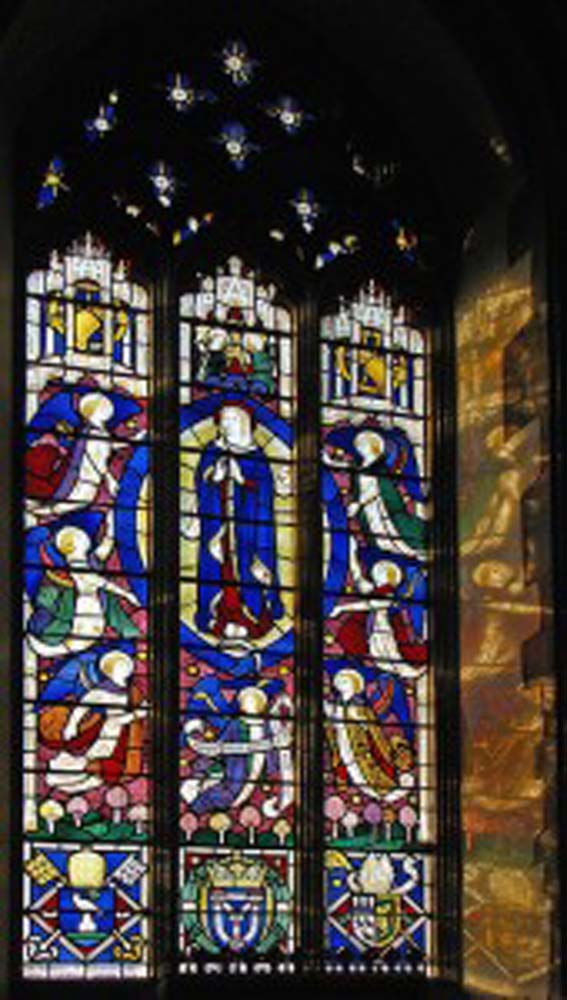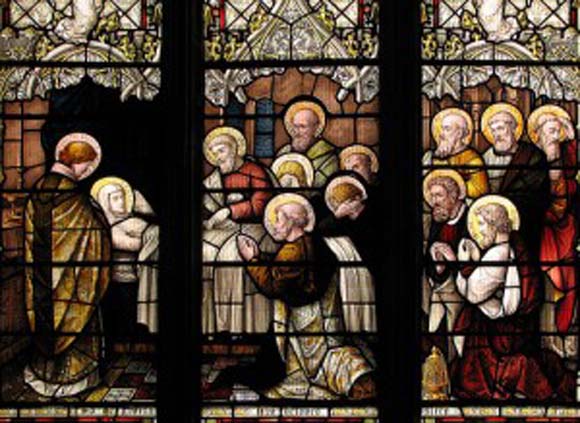
Mother of Redeemed Humanity
1.26k
Readings: Revelation 11:19, 12:1-6,10; Psalm 44; 1 Corinthians 15:20-26; Luke 1:39-56
 Elizabeth calls Mary “the mother of my Lord”, and her use of the word ‘Lord’ is significant because it refers to God, the Lord whom Mary praises in her ‘Magnificat’. And so, every time we pray the ‘Hail Mary’, we repeat the words of both Gabriel and Elizabeth, and we echo Elizabeth’s greeting when we call Mary “Mother of God”. But it’s not because Mary is Mother of God that we celebrate today’s feast. No, we celebrate Mary’s Assumption, when “the ever Virgin Mary, having completed the course of her earthly life, was assumed body and soul into heavenly glory” because Mary is ‘Mother of Man’, the Mother of Humanity.
Elizabeth calls Mary “the mother of my Lord”, and her use of the word ‘Lord’ is significant because it refers to God, the Lord whom Mary praises in her ‘Magnificat’. And so, every time we pray the ‘Hail Mary’, we repeat the words of both Gabriel and Elizabeth, and we echo Elizabeth’s greeting when we call Mary “Mother of God”. But it’s not because Mary is Mother of God that we celebrate today’s feast. No, we celebrate Mary’s Assumption, when “the ever Virgin Mary, having completed the course of her earthly life, was assumed body and soul into heavenly glory” because Mary is ‘Mother of Man’, the Mother of Humanity.
 As Mother of the Church, then, Mary is our Mother, and she is the first in the Church to benefit from Christ’s promises. She is the first to receive the grace of divine adoption, so in today’s psalm she is called ‘daughter’. And today we celebrate that she is the first to rise body and soul into heaven to be with God. So, the eternal life that was promised to her by her adoption as a child of God, a sharer in the divine life, was fulfilled at the end of her earthly life. So too with us … When our earthly life is ended, we hope that the promise given to us in baptism will be fulfilled by God’s grace, so that we too will be assumed body and soul into heavenly glory!
As Mother of the Church, then, Mary is our Mother, and she is the first in the Church to benefit from Christ’s promises. She is the first to receive the grace of divine adoption, so in today’s psalm she is called ‘daughter’. And today we celebrate that she is the first to rise body and soul into heaven to be with God. So, the eternal life that was promised to her by her adoption as a child of God, a sharer in the divine life, was fulfilled at the end of her earthly life. So too with us … When our earthly life is ended, we hope that the promise given to us in baptism will be fulfilled by God’s grace, so that we too will be assumed body and soul into heavenly glory!
 Elizabeth calls Mary “the mother of my Lord”, and her use of the word ‘Lord’ is significant because it refers to God, the Lord whom Mary praises in her ‘Magnificat’. And so, every time we pray the ‘Hail Mary’, we repeat the words of both Gabriel and Elizabeth, and we echo Elizabeth’s greeting when we call Mary “Mother of God”. But it’s not because Mary is Mother of God that we celebrate today’s feast. No, we celebrate Mary’s Assumption, when “the ever Virgin Mary, having completed the course of her earthly life, was assumed body and soul into heavenly glory” because Mary is ‘Mother of Man’, the Mother of Humanity.
Elizabeth calls Mary “the mother of my Lord”, and her use of the word ‘Lord’ is significant because it refers to God, the Lord whom Mary praises in her ‘Magnificat’. And so, every time we pray the ‘Hail Mary’, we repeat the words of both Gabriel and Elizabeth, and we echo Elizabeth’s greeting when we call Mary “Mother of God”. But it’s not because Mary is Mother of God that we celebrate today’s feast. No, we celebrate Mary’s Assumption, when “the ever Virgin Mary, having completed the course of her earthly life, was assumed body and soul into heavenly glory” because Mary is ‘Mother of Man’, the Mother of Humanity.
Jesus Christ, after all, is not just “true God from true God”, but also true man, fully human. And the defining characteristic of humanity is to be a unity of rational soul-and-body. The human body, then, is ensouled, and it is sacred from conception to the grave. And so, when we speak of Christ becoming human, we say that “the Word became flesh, and dwelt among us”. The eternal Word took his flesh from the Virgin Mary, fashioning a body for himself in her womb, with a human face that is in her image and likeness. And so, although Mary is called ‘Mother of God’, she is also rightly called ‘Mother of Man’, since she is Mother of Jesus Christ who is true man, the second Adam.
St Paul alludes to this in the second reading. Sin and death affect all human beings because Adam stood for humanity. Christ became Man so that he could represent humankind, uniting humanity to his divinity. By his love and obedience even to the point of death on the Cross, Christ overturned the disobedience of Adam. So, by his Incarnation and death, Jesus redeemed humanity, and became a second Adam who gives us life because as God-Man he was victorious over death. As Paul says, Christ is the first to rise from the dead. But all human beings will share in his victory “in their proper order”. And the first after Christ to experience the resurrection of the flesh is Our Lady.
If we look at our first reading, it is interesting to note that the writer of the Apocalypse models Mary after the first Mother of Humanity. Like Eve in Genesis, she is called ‘Woman’, and she is subject to the pangs of childbirth. So, Mary fully shares our human condition. However, she is surrounded by heavenly signs: the sun, stars, and the moon, and these speak of her union with God through grace, and her heavenly destiny. So, if Christ is the second Adam, then the second Eve is Mary, because she is, as I’ve suggested, the Mother of Man. But she is not the Mother of fallen humanity, as Eve was. No. She is the Mother of true man.
What does it mean to be truly human? It is sometimes said that to err is human, but actually to sin is to be less-than-human because sin de-humanizes us and deforms us, and we fail to be truly made in the image of God. It is Christ, the second Adam who restores the beauty of the image of God in us. By his grace, he remakes us in his image as true man, and the first person to receive this grace in its fullness is Mary, who is thus immaculate and all beautiful. This is why she can be called the Mother of true man: we mean that Mary is the Mother of Redeemed Humanity, of all people who are united to Christ in baptism, and who are promised a share in his divine life. In short, Mary is called ‘Mother of the Church’.
 As Mother of the Church, then, Mary is our Mother, and she is the first in the Church to benefit from Christ’s promises. She is the first to receive the grace of divine adoption, so in today’s psalm she is called ‘daughter’. And today we celebrate that she is the first to rise body and soul into heaven to be with God. So, the eternal life that was promised to her by her adoption as a child of God, a sharer in the divine life, was fulfilled at the end of her earthly life. So too with us … When our earthly life is ended, we hope that the promise given to us in baptism will be fulfilled by God’s grace, so that we too will be assumed body and soul into heavenly glory!
As Mother of the Church, then, Mary is our Mother, and she is the first in the Church to benefit from Christ’s promises. She is the first to receive the grace of divine adoption, so in today’s psalm she is called ‘daughter’. And today we celebrate that she is the first to rise body and soul into heaven to be with God. So, the eternal life that was promised to her by her adoption as a child of God, a sharer in the divine life, was fulfilled at the end of her earthly life. So too with us … When our earthly life is ended, we hope that the promise given to us in baptism will be fulfilled by God’s grace, so that we too will be assumed body and soul into heavenly glory!
Sometimes people speak as if heaven is a place for spirits only, or we might be tempted to think that we are souls trapped in bodies. Our society today often shows a contempt for the human body, or it uses it as a sex object, or treats it as a commodity. Drug abuse, pornography and prostitution, embryonic stem-cell research, the sale of human organs, and so on, are all examples of the denigration of the body, and ultimately of the human person.
But our faith teaches, and this feast reminds us, that the resurrection of the dead will take place in the flesh, and so we should revere the human body. As the Church Father Tertullian said: Caro cardo salutis: “the flesh is the hinge of salvation”. We believe in God who is creator of the flesh. We believe in the Word made flesh in order to redeem the flesh. We believe in the resurrection of the flesh, which is the fulfillment of both the creation and the redemption of the flesh. Therefore, we celebrate Our Lady’s Assumption because this event is the fulfillment of God’s promise to redeemed humanity. So, it is because Mary is ‘Mother of Man’ that we celebrate this feast.
As we wait for God’s promise to be fulfilled in us, waiting for the resurrection of our flesh, let us make the words of our Mother to be our own words, since what God has done for Mary, he will also do for us: “My soul proclaims the greatness of the Lord and my spirit exults in God my saviour; because he has looked upon his lowly servant. Yes, from this day forward, all generations will call me blessed, for the Almighty has done great things for me”!


